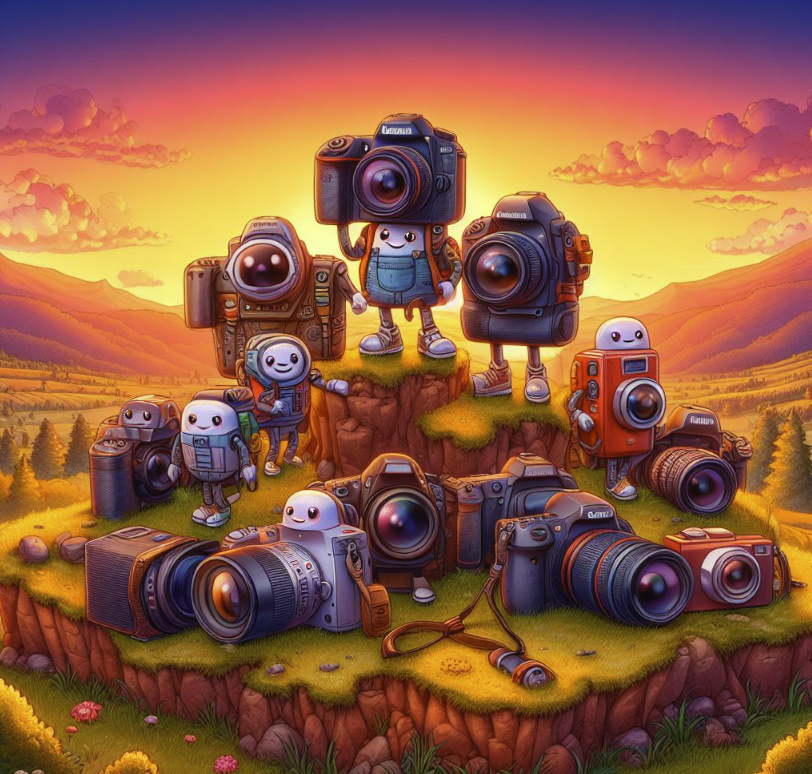As a beginner, choosing between a point-and-shoot camera and DSLR camera can be a daunting task.
With so many options available, it’s important to understand the differences between point-and-shoot cameras and DSLR cameras to make an informed decision.
Point-and-Shoot vs. DSLR Cameras
Point-and-Shoot Cameras:
- Size: Compact and lightweight, making them highly portable.
- Ease of Use: Generally user-friendly with automatic settings.
- Price: Tend to be more affordable than DSLRs.
- Lens: Fixed lens, limiting zoom and aperture capabilities.
- Quality: Good image quality, but typically not as high as DSLRs.
DSLR Cameras:
- Size: Larger and heavier due to the mirror mechanism and larger sensor.
- Ease of Use: Can be used in auto mode but also offer extensive manual controls for more advanced photography.
- Price: Generally more expensive, especially when considering additional lenses and accessories.
- Lens: Interchangeable lenses, providing versatility in shooting different types of photos.
- Quality: Tend to offer superior image quality and performance, especially in low light.
Point-and-shoot cameras are suitable for casual photographers and travelers who prioritize portability and simplicity, while DSLR cameras cater to both enthusiasts and professionals who seek higher image quality and greater control over their photography.
Below we look deeper the advantages and disadvantages of each type of camera, and ultimately determine which is better for beginners.
Table of Contents
1. Point-and-Shoot Cameras
Point-and-shoot cameras, also known as compact cameras, are designed for simplicity and convenience.
They are lightweight, portable, and easy to use, making them a popular choice for beginners.
Here are some key features of point-and-shoot cameras:
- Automatic settings: Point-and-shoot cameras come with built-in automatic settings that adjust the exposure, focus, and other settings based on the scene. This makes it easy for beginners to capture good quality photos without having to worry about technical details.
- Compact size: Point-and-shoot cameras are small and lightweight, making them ideal for travel and everyday use. They can easily fit into a pocket or a small bag, allowing you to capture moments on the go.
- Fixed lens: Point-and-shoot cameras have a fixed lens, which means you cannot change the focal length or zoom in and out. While this may limit your creative options, it also eliminates the need to carry around multiple lenses.
- Affordability: Point-and-shoot cameras are generally more affordable compared to DSLR cameras. This makes them a great option for beginners who are on a budget or unsure if photography is a long-term hobby.
2. DSLR Cameras
DSLR cameras, short for digital single-lens reflex cameras, are more advanced and offer greater control over the photographic process.
They are larger and heavier than point-and-shoot cameras, but they also provide superior image quality and versatility. Here are some key features of DSLR cameras:
- Interchangeable lenses: One of the biggest advantages of DSLR cameras is the ability to change lenses. This allows you to adapt to different shooting situations and achieve a wide range of creative effects. From wide-angle to telephoto, there is a lens for every type of photography.
- Manual controls: DSLR cameras offer manual controls for adjusting settings such as aperture, shutter speed, and ISO. This gives you full control over the exposure and allows you to experiment with different techniques to achieve the desired results.
- Image quality: DSLR cameras have larger image sensors compared to point-and-shoot cameras, resulting in better image quality, especially in low-light conditions. They also offer higher resolution and the ability to capture more detail.
- Speed and performance: DSLR cameras have faster autofocus systems and continuous shooting modes, making them suitable for capturing fast-moving subjects such as sports or wildlife. They also have shorter shutter lag, allowing you to capture the moment without any delay.
3. Which is Better for Beginners?
Now that we have explored the features of both point-and-shoot cameras and DSLR cameras, let’s discuss which is better for beginners:
Point-and-shoot cameras are better for beginners who:
- Are looking for simplicity and ease of use.
- Want a lightweight and portable camera for everyday use or travel.
- Have a limited budget and want an affordable option.
- Are not interested in learning the technical aspects of photography.
DSLR cameras are better for beginners who:
- Are willing to invest time and effort in learning photography techniques.
- Want greater control over the creative process.
- Are interested in exploring different types of photography and experimenting with different lenses.
- Value superior image quality and performance.
Overall, the choice between a point-and-shoot camera and a DSLR camera depends on your personal preferences, budget, and level of commitment to photography.
If you are just starting out and want a simple and convenient camera, a point-and-shoot camera may be the best option for you.
However, if you are passionate about photography and want to take your skills to the next level, investing in a DSLR camera can provide you with more creative possibilities and better image quality.
FAQs – Point-and-Shoot vs. DSLR Cameras: Which is Better for Beginners?
1. What is the main difference between point-and-shoot cameras and DSLR cameras?
The main difference between point-and-shoot cameras and DSLR cameras is the level of control and versatility they offer.
Point-and-shoot cameras are designed for simplicity and convenience, with automatic settings and a fixed lens.
On the other hand, DSLR cameras provide manual controls, interchangeable lenses, and superior image quality.
2. Are point-and-shoot cameras suitable for professional photography?
While point-and-shoot cameras can produce good quality images, they are generally not suitable for professional photography.
Professional photographers often require the flexibility and control that DSLR cameras offer, along with the ability to use different lenses and accessories.
3. Can I achieve professional-looking photos with a point-and-shoot camera?
Yes, it is possible to achieve professional-looking photos with a point-and-shoot camera.
By understanding composition, lighting, and other photography techniques, you can capture stunning images regardless of the camera you are using.
However, DSLR cameras provide more options and control for achieving professional results.
4. Are DSLR cameras more expensive than point-and-shoot cameras?
Yes, DSLR cameras are generally more expensive than point-and-shoot cameras.
This is due to their advanced features, larger image sensors, and the ability to change lenses.
However, there are entry-level DSLR cameras available at affordable prices for beginners.
5. Do I need to learn photography techniques to use a point-and-shoot camera?
No, one of the advantages of point-and-shoot cameras is their simplicity. They come with automatic settings that adjust the exposure and focus for you.
However, learning basic photography techniques can help you improve your composition and make the most out of your camera.
6. Can I use DSLR lenses on a point-and-shoot camera?
No, DSLR lenses are not compatible with point-and-shoot cameras. Point-and-shoot cameras have a fixed lens that cannot be changed or removed.
DSLR lenses are designed specifically for DSLR cameras and cannot be used on other types of cameras.
7. Which camera is better for travel photography?
Both point-and-shoot cameras and DSLR cameras can be suitable for travel photography, depending on your preferences.
Point-and-shoot cameras are lightweight and portable, making them convenient for capturing moments on the go.
DSLR cameras, on the other hand, offer greater control and image quality, allowing you to capture stunning landscapes and details.
8. Can I achieve shallow depth of field with a point-and-shoot camera?
Shallow depth of field, which creates a blurred background and a sharp subject, is more difficult to achieve with a point-and-shoot camera compared to a DSLR camera.
Point-and-shoot cameras have smaller image sensors and fixed lenses, which limit their ability to create a shallow depth of field effect.
9. Are DSLR cameras more durable than point-and-shoot cameras?
Generally, DSLR cameras are built to be more durable and withstand harsh conditions compared to point-and-shoot cameras.
They are designed for professional use and often come with weather-sealing to protect against dust and moisture.
However, there are also rugged point-and-shoot cameras available that are designed for outdoor and adventure photography.
10. Can I shoot in RAW format with a point-and-shoot camera?
Some point-and-shoot cameras do offer the option to shoot in RAW format, which allows for greater flexibility in post-processing.
However, this feature is more commonly found in DSLR cameras.
Shooting in RAW format gives you more control over the final image and allows for better adjustments in terms of exposure, white balance, and color.
Summary – Point-and-Shoot vs. DSLR Cameras: Which is Better for Beginners?
Choosing the right camera as a beginner is crucial to your photography journey.
Point-and-shoot cameras offer simplicity, affordability, and convenience, making them a great choice for beginners who want to capture moments without getting into the technical details.
On the other hand, DSLR cameras provide greater control, versatility, and superior image quality, making them suitable for beginners who are willing to invest time and effort in learning photography techniques.
Overall, the decision depends on your personal preferences and level of commitment to photography.


